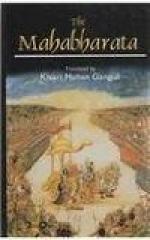480. Pravaras indicate the race in which one is born. They are named from the names of the Vedic Rishis.
481. The commentator explains that ayonim implies of unknown birth and viyonim of mean birth.
482. Brahmanih here refers to the rituals in the Vedas and not persons of the first order.
483. The fact is, one is directed to bathe after a shave. One is considered impure after a shave until one bathes.
484. Uddesa means, as the commentator explains, in brief.
485. The word rendered conduct in the concluding verse of this lesson is acharah. It implies not only one’s behaviour to one’s own self and others, i.e., to beings inferior, equal, and superior. The word acharah, therefore, includes the entire body of acts that one does in this life, including the very sentiments that one cherishes.
486. The flower of the cane cannot be plucked for being offered to the deities.
487. An Acharya is an ordinary instructor. He is called an Upadhyaya who teaches the Vedas. The Upadhyaya is greater than even ten Acharyas or ordinary teachers. The father, again, deserves ten times as much respect as is paid to the Upadhyaya. As regards the mother, again, the reverence due to her is greater than what is due to the father. The mother is equal to the whole earth.
488. Many of the verses of this Lesson are from Manu. The relative positions of the Acharya, the Upadhyaya, the father, and the mother, as given in verse 15, is not consistent with Manu. verse 15 would show that the Upadhyaya was regarded as very much superior of the Acharya. In Manu, II—140-41, he is called an Acharya who taught all the Vedas, without any remuneration. He, on the other hand, who taught a particular Veda for a living, was called an Upadhyaya. The first line of verse 19 corresponds with Manu, II—148. The sense is that that birth which one derives from one’s parents is subject to death; while the birth derived from the preceptor is true regeneration, unfading and immortal. It is a question whether any other nation paid such respect to persons employed in teaching.
489. Kanchi is an ornament worn by ladies round the waist or hips. There is a shining disc of gold or silver, which dangles on the hip. It is commonly called Chandra-hara. The Nupura is an anklet of silver, with moving bullets placed within, so that when the wearer moves, these make an agreeable sound.
490. In verse 3, Avaguna means Nirguna; Ekatma means alone and asamhta implies without associates i.e., helpless.
491. A Padma is a very large number. Instead of rendering such words exactly, have, in some of the preceding verses, following the sense, put down ‘millions upon millions of years.’
492. Avartanani means years. Four and twelve make sixteen, Sara is arrow. The arrows are five in number as possessed by Kama, the deity of love. The number of fires also is seven. The compound saragniparimana, therefore, implies five and thirty. Adding this to sixteen, the total comes up to one and fifty.




